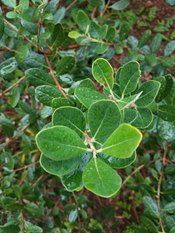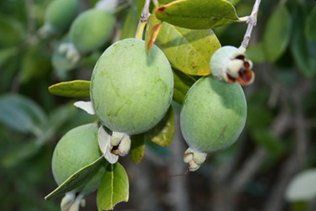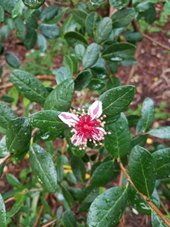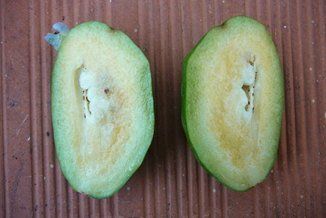Another Incredible Edible for Your Garden
Acca sellowiana: Pineapple Guava
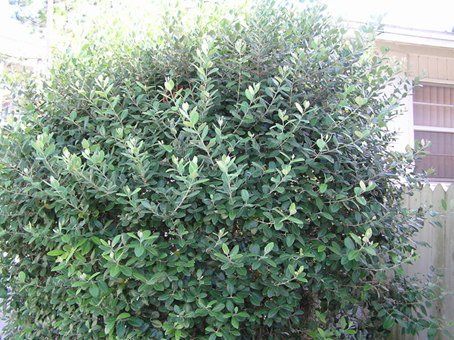
"Acca sellowiana" by tillandsiausneoides is licensed under CC BY-SA 2.0
In the past year gardening has seen a major increase in popularity. As more people begin to garden, certain plants have seen more interest from the public. One group that has seen an increase is perennial plants that produce edible fruits, especially trees and shrubs. With a variety of fruiting trees, shrubs, and perennials that can thrive in the Tidewater area, I would like to talk about a lesser-known fruiting shrub, the Pineapple Guava. Native to South America, Pineapple Guava, Acca sellowiana (previously Feijoa sellowiana) is an evergreen shrub that produces small edible fruit. Primarily used as an ornamental shrub for its flowers and form, this plant has been found to produce fruit successfully in the Tidewater climate.
Pineapple Guava is an evergreen shrub that was brought from South America as an ornamental plant. It soon gained a niche in the south for its versatility in the landscape. Originally found in tropical climates, this plant made its way to more temperate zones. It can be pruned like a decorative shrub, used as a hedge, or potted. The leaves are glossy green with a silvery underside. Flowers have light pink petals with white edges and a deep red center and later produce egg sized/shaped fruit.
Leaves, fruit, and flowers
Pineapple Guava is a slow growing shrub. Plants require little pruning but tolerate it well. It is hardy in zones 8-10, salt tolerant, and grows in soils with good drainage ranging from sand to clay and dry to moderate moisture. Prefers full sun but can tolerate part shade. Growth can reach 10-15ft. height and spread in tropical climates and is condensed to 5-6 ft. in more temperate zones. Moderate water and full sun are recommended for best flowering and fruiting. The shrub itself has no major pest issues but critters are known to snag some fruit for themselves and fruit litter can be another issue.
The fruit of the pineapple guava is one of its most underrated features. Fruits have a sweet/tangy flavor and are eaten as a dessert. The fruit is usually sliced in half to scoop out the edible pulp. Flowering occurs in spring-summer and development of fruit usually occurs summer, fall or winter, both of which depend on the climate. In warmer climates flowers and fruit develop earlier. In the Tidewater area flowering usually occurs May to June with fruit appearing in the fall or winter. Once ripe the fruit will easily fall off the plant. The most common harvest method is to lay out a tarp and shake the branches over it to gather (Note that the fruit bruises easily). The fruit should be eaten or stored in the fridge immediately after harvesting. Flowers can also be eaten and are known to have a light sugary taste similar to marshmallows. Frost and heat stress may disrupt some production and cause early fruit drop. For fruit production it is best to select a self-pollinating cultivar.
As gardening becomes more popular, people are looking for beautiful, unique, and interesting plants. With this rise in interest, less appreciated plants are coming into the limelight. Fruit trees and shrubs have always experienced more attention from the public and are likely to see a rise. If you’re looking for a niche fruit tree that doubles as a lovely ornamental plant, consider the Pineapple Guava.
References
Acca sellowiana. (n.d.). Retrieved from https://www.ces.ncsu.edu/
Acca sellowiana. (n.d.). Retrieved from http://www.missouribotanicalgarden.org/

